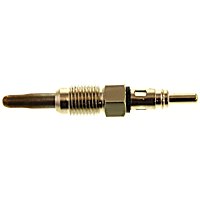Knowing the difference between a spark plug and a glow plug can be tough if you’re not familiar with basic auto parts. While you might think the two components are similar, in reality, they’re entirely different. Spark plugs are used in gas-powered engines, whereas glow plugs are used in diesel applications. The two components also serve completely different purposes.
To make the concept less confusing, let’s take a closer look at the differences between spark plugs and glow plugs.

Spark Plugs
What Are Spark Plugs?
Spark plugs are used in gas-powered internal combustion engines. Typically, there’s one spark plug for each of the engine’s cylinders.
Each spark plug has a metal body, ceramic insulator, internal resistor, and a pair of electrodes. A spark plug wire or ignition coil attaches to the terminal end of the spark plug. The other end of the plug protrudes into the engine’s combustion chamber
High-voltage from the car’s ignition system travels to the terminal at each of the spark plugs. From there, the voltage goes through the spark plug’s internal resistor before reaching the electrodes at the tip. The voltage then jumps a gap between the electrodes, creating an arc that ignites the engine’s air-fuel mixture.
The resulting explosion forces the piston downward in the cylinder, causing the engine’s crankshaft to turn. As the crankshaft turns, it creates the rotational force needed to propel your vehicle down the road.
You can learn more by watching this video on spark plug operation:
How Often to Replace Spark Plugs
There are three primary types of spark plugs—copper, platinum, and iridium—each of which has a different life expectancy.
Copper plugs have a copper center electrode covered in nickel alloy. The design typically lasts around 30,000 miles.

Platinum plugs have a platinum disk attached to the tip of their center electrode. There are also so-called double platinum plugs that have platinum at both tips. Because platinum is more durable than nickel alloy, platinum plugs last longer than copper plugs. You can expect to replace a set of platinum plugs every 90,000 to 100,000 miles.
Iridium plugs, which have a fine electrode made of iridium, are becoming increasingly popular. Because iridium is harder than platinum, it lasts longer, making this type of plug good for up to 120,000 miles.
To determine when your plugs should be replaced, you’ll want to consult the vehicle manufacturer’s maintenance schedule. You can find this information in the owner’s manual or supplemental service booklet.
Check out our article on how to change spark plugs for an idea of what the job typically entails.

Glow Plugs
What is a Glow Plug?
Glow plugs are used in diesel-powered internal combustion engines. While spark plugs ignite the engine’s air-fuel mixture whenever the vehicle is running, glow plugs act as a starting aid to get the engine going.
Diesel engines rely on the heat from the compression of air to ignite fuel, making them difficult to start when cold. Many diesel-powered vehicles use glow plugs to address this issue. The glow plugs act as heating elements to preheat the air in the combustion chambers, making the vehicle easier to start. Diesel engines typically have one glow plug per cylinder.
Each glow plug has a terminal, a threaded body, and a tip the protrudes into the engine’s combustion chamber. Applying voltage to the terminal end of the plug allows electrical current to pass through a heating element in the plug’s tip. The plug’s body, which is threaded into the cylinder head, acts as an electrical ground for the heating element.
You can learn more by watching this video on glow plug operation:
How Often To Replace Glow Plugs
Unlike spark plugs, glow plugs do not have a recommended service schedule. Glow plugs only require replacement when they fail or wear out.
If you need to determine whether your vehicle’s glow plugs require replacement, check out our article: How to Test Glow Plugs The Right Way: A Step-by-Step Guide.
Where to Get Ignition Parts for Your Ride
Looking to replace ignition parts on your vehicle? Look no further than CarParts.com. Whether you need new spark plugs, glow plugs, or any other ignition components, we’ve got you covered.
We carry a wide selection of ignition system parts for various makes and models of vehicles. Our comprehensive inventory includes aftermarket ignition parts from trusted brands, ensuring compatibility and reliability.
To get started, simply input your vehicle’s details into our search tool, and we’ll present you with a tailored selection of ignition system components. What’s more, we have distribution centers located across the country to ensure fast and efficient shipping.
Don’t let ignition issues leave you stranded. Explore our selection of high-quality parts today and keep your ride running smoothly!
Products Mentioned in this Guide
Any information provided on this Website is for informational purposes only and is not intended to replace consultation with a professional mechanic. The accuracy and timeliness of the information may change from the time of publication.


 Spark Plug
Spark Plug
 Glow Plug
Glow Plug



























